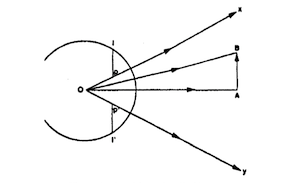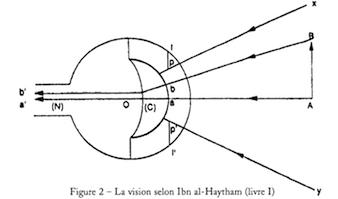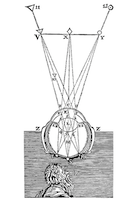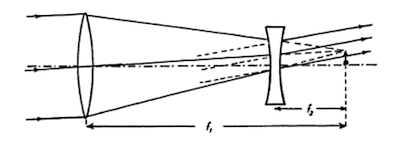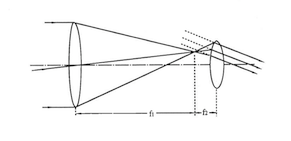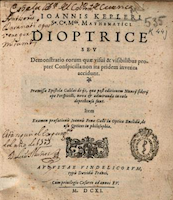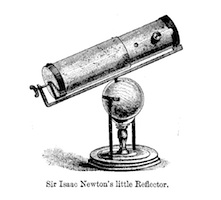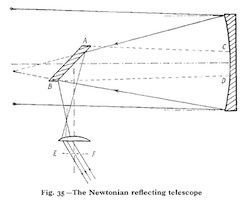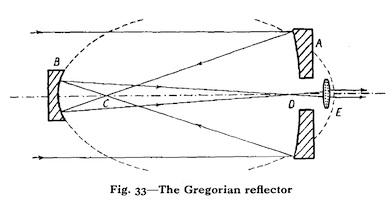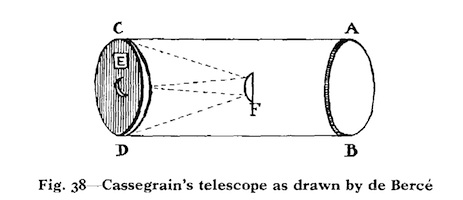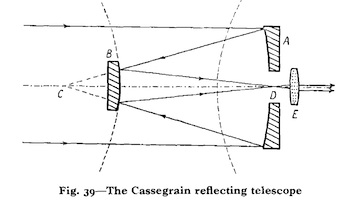«Our past is part of our present culture, and we can legitimately incorporate it; but our present knowledge is not part of past cultures, and we should not assume it was known when we make history – be it history of science, history of philosophy or any other history»
Gérard Simon, Sciences et Savoirs aux XVIe et XVIIe siècles, 1996, p 28.
From Greek antiquity to Alhazen and Kepler
Our knowledge of optics at the time of the ancient Greeks is based on two books written at an interval of more than five centuries. The first is Euclid’s optical treaty, written by this famous mathematician who lived around the fourth century BC. We hardly know anything about his life, but we do have access to the entirety of the Greek version of his Optica.
The second book is the Optica of astronomer Ptolemy, who lived in Alexandria in the second century. His great treatise on astronomy is well known thanks to translations made by Arab scholars, beginning in the eighth century, under the title Almageste1. However, only a portion of his optical treatise has survived2.
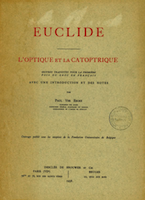 |
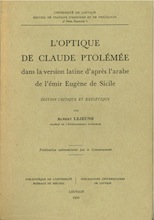 |
Ptolemy revisited and further developed the mathematical analysis of Euclid. Among the various theories of vision developed by his predecessors – theories that, in the absence of evidence, are necessarily based on speculation - he opts, like Euclid, in favour of the one based on the concept of a visual ray "emanating from the eye and hitting the object3”.
This theory proved to be false – the visual ray does not emanate from the eye but enters it– but it did not prevent him from having a fair knowledge of some optical phenomena, including those that can be interpreted in a purely geometric way: reflection on a flat mirror and refraction from one medium to another (from air into water or from air into glass, for example).
As Euclid, Ptolemy knew the law governing the reflected visual ray. Regarding the fragmented visual ray (refraction), he managed to experimentally produce deviation tables, but failed to establish the sine law that governs this phenomenon. Ptolemy is also the first astronomer - and of course not the last - to be interested in the atmospheric refraction that affects observations of the Moon and the Sun.
Despite these significant progresses in the field of optical phenomena -particularly important for the further development of positional astronomy (atmospheric refraction) and instrumental astronomy (reflection on a mirror, refraction of air in the glass) - the theory of vision that Ptolemy held prevented him from developing a coherent optical science. As with his purely geometrical theory, the eye has no other role than that of emitter of visual rays, Ptolemy did not question the functioning of this organ. In the absence of questions about that which enters the eye - light - and the image formed in and by the eye, the optical theory could not evolve.
Basing his thinking on the concept of a visual ray emanating from the eye, he did not question himself about the light that enters the eye or about the process of formation of the perceived image.
Vision according to Ptolemy (click image to enlarge)
About eight centuries after Ptolemy, the Arab scholar Ibn al-Haytham4, known as Alhazen in the medieval West – got interested in optical questions and vision and approached them in a very innovative way. Indeed, he was the first in addressing them through experiments. Numerous and reproducible, they allowed him to prove that "vision occurs through light rays entering the eye and not through visual rays coming out, as postulated geometrical optics of antiquity5"..
The works of Alhazen thus allow a definitive choice between the different speculative theories of vision that were in competition since Greek antiquity. By reversing the direction of the visual rays, Alhazen also raised the question of the formation of images, an unanswered question when the visual ray was thought to come out of the eye to go and hit directly the object seen.
Vision according to Alhazen (click image to enlarge)
Known and rapidly adopted since the twelfth century in the West, the truly revolutionary concept of vision established by Alhazen raised efforts on both the nature of light and the functioning of the eye - the organ for image formation.
*
In the early sixteenth century, the theory of the interference of visual rays is revisited and improved by the German astronomer Kepler, a scientist interested both in theory and in experimentation.
By studying the observations of Mars bequeathed to him in Prague by Tycho Brahe - his illustrious Danish predecessor at the court of Emperor Rudolf II - Kepler became interested in the corrections of atmospheric refraction, and, more generally, in optical phenomena.
Simultaneously, Kepler studied the phenomenon of vision - including its physiological dimension. In 1604, he was the first to establish that the eye works as a darkroom.
Illustration taken from Descartes’ work "La Dioptrique" showing the formation of the image on the retina (in his work "Astronomia Pars Optica" published in 1604 Kepler did not include illustrations of his theory of vision.
In 1610, the Duke of Bavaria was visiting Prague and lended Kepler, for a few months, a telescope built on the model developed in Venice the previous year by Galileo.
Shortly after, Kepler established the theory that Galileo had not developed, and hastened to design a radical improvement. Like Galileo, he placed in front of the tube of his telescope a converging glass lens that produced an image of the star. However, while Galileo had placed in the back of the tube a diverging ocular for enlarging the image, Kepler used a converging one.
Meanwhile, Kepler established the first theory of lenses –which he published in 1611 in his work Dioptricae.
From refraction telescopes to reflection telescopes
Interestingly, the instrument with which Galileo made his great discoveries since 1609 had remained nameless. It was prince Cesi who, in April 1611, called it telescopium. Founder in 1603 of the Academy of Lynx, the first European scholar academy, Cesi invented this name during a dinner organized by members of his academy in honour of Galileo.
Nevertheless, because it was unpractical for astronomers, the Galileo’s telescopium quickly fell into oblivion. In contrast, Kepler’s telescopium was being used across Europe: the Germans called it Fernrohr Refraktor, the English (refracting) telescope, the French lunette astronomique and the Italians telescopio.
Around 1668, a young English scientist, Newton, became interested in a mysterious optical phenomenon: the "appearance" (in Latin “spectrum”) of coloured light beams after a ray of white light went through a prism glass. He made many experiments to try to understand how this decomposition of white light occurs. One of them – which involves sending a beam of coloured light through a lens and then through a glass prism – allowed Newton to reconstruct the coloured beams into white light …and to demonstrate that the appearance (spectrum) of colours comes not from intrinsic glass qualities but from the white light itself.
Newton then established that the different colours hidden in the white light are not equally deflected in the same angle when passing through the prism. This led him to establish the laws of refraction.
Thanks to his theoretical tools, Newton was able to explain why the image of an star observed with Kepler’s telescope is colourful: after refraction through the lens, the violet colour converges closer to the lens than the red colour, so that when we observe the image of the star with the ocular, it exhibits an iridescent appearance.
This chromatic aberration is particularly troublesome if the focus of the lens is short. With time, this led the astronomers to build longer and longer telescopes –very inconvenient to manipulate.
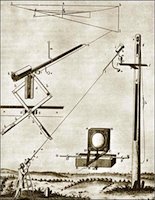
66 m long aerial telescope. Engraiving taken from Huygens’ work "Astroscopia Compendiaria tubi optici molimine liberata" published in 1684.
Convinced - mistakenly - that this defect of Kepler’s telescopium was insurmountable, Newton invented a new instrument free of chromatic aberration. His telescopium did not form the image of the star by refraction trough a convergent lens, but by reflection on a concave mirror. Since all white-light colours converge at the same point after reflection from a mirror, the image produced by the reflecting telescope is free from the chromatic aberration characteristic of Kepler’s instrument.
When, in 1668, Newton built an initial prototype of his reflection telescope, he polished a concave mirror of a few inches in diameter that he made with a highly reflective metallic alloy that he composed himself.
Newton’s telescope (click image to enlarge)
In 1671 the Royal Society showed interest in this invention and requested the famous Cambridge mathematician to present it at the Academy. The following year, the new instrument was the subject of considerable controversy. Newton was not the precursor he claimed to be, as in 1663 a brilliant Scottish mathematician, Gregory, had published in his work Optica Promota the description of a telescope with a concave mirror.
Gregory’s telescope (click image to enlarge)
Moreover, shortly after the publication in 1672 in the “Journal des Sçavants” of a laudatory presentation of Newton’s telescope written by Huygens, a description of a third reflecting telescope appeared in the same journal, this one made by Cassegrain, obscure Professor at the Royal College of Chartres.
Cassegrain’s telescope (click image to enlarge)
From theory to practice
Gregory and Cassegrain had both imagined the astronomer observing behind the instrument – as with Kepler’s telescope. For doing this, the main mirror of their telescope had to be pierced in its centre with a small hole, in order to place the ocular. Gregory sent the light reflected by the main mirror to this ocular with a small concave mirror. While Cassegrain chose a secondary convex mirror that had the advantage of correcting some aberrations of the main mirror. As for Newton, he made use of a small plane mirror, placed at 45 ° to the optical axis of the large mirror, to send the light of the star reflected by the large mirror into the eyepiece. In the case of Newtonian combination, the astronomer did not observe from behind the telescope tube, but from the side, near the front of the telescope tube.
From a practical point of view, the glass lenses of Kepler’s telescope are considerably easier to make than main concave speculum mirrors. Furthermore, refracting telescopes are significantly brighter than metal mirror telescopes, which tarnish quickly and must be carefully repolished very often. Another difference is that the construction of the mechanical part of the instrument and the assembly of optical parts are easier to achieve in the case of the Kepler telescope: simple telescopic cylindrical cardboard tubes carry on one side the lens and on the other the ocular. In the case of a reflecting telescope, the alignment of the main mirror, the secondary mirror – plane for Newton, concave for Gregory or convex for Cassegrain – and the ocular is very difficult to perform and, once achieved, is easily disrupted.
In fact, no English optician succeeded in building a Gregory type telescope and no French optician ventured to build a Cassegrain type telescope. At the end of the seventeenth century, there only stayed in competition the optical combination of the most famous of the three inventors ... who himself preferred to use a refracting telescope for his own astronomical observations.
Notes
1. And to subsequent translations from Arabic into Spanish and Latin made in the West starting in the twelfth century.
2. The Greek original, the foundation of the Arabic translation, has disappeared. There remains the Latin translation - incomplete – of this Arabic translation, itself lost.
3. Gérard Simon. Science Savoirs aux XVIe et XVIIe siècle, Villeneuve d’Ascq, Presses universitaires du Septentrion, p.14, 1996, 225 p.
4. Born at Bassora (Iraq) in 965 and deceased at Cairo around 1039.
5. Gérard Simon. Optique et perspective : Ptolémée, Alhazen, Alberti. In Peinture et Musique : Penser la vision, penser l’audition. Ed. Catherine Kintzler. Septentrion Presses Universitaires. 19-36, 2002.
Images credits
1. Cover page «Euclide: L’optique et la catoptrique»: Euclide, Paul Ver Eecke. Fondation Universitaire de Belgique, 1938.
2. Cover page «Ptolémée: L’optique»: Claude Ptolémée, Eugène de Sicile, Albert Lejeune. L’optique de Claude Ptolémée dans la version latine d’après l’arabe de l’émir Eugène de Sicile. Louvain, 1956.
3. Vision according to Ptolemy: Gérard Simon. Sciences et savoirs aux XVIe et XVIIe siècles. Presses universitaires du Septentrion, p. 15, 1996.
4. Vision according to Alhazen: Gérard Simon. Sciences et savoirs aux XVIe et XVIIe siècles. Presses universitaires du Septentrion, p. 15, 1996.
5. Formation of the image on the retina: William C. Wees. Light Moving in Time: Studies in the Visual Aesthetics of Avant-Garde Film. Berkeley, University of California Press, 1992.
6. Galileo’s telescope: Henry C. King. The History of the Telescope. Griffin & Company Limited, London, p.36, 1955.
7. Kepler’s telescope: Henry C. King. The History of the Telescope. Griffin & Company Limited, London, p.45, 1955.
8. Cover page «Kepler: Dioptrice»: Books.google.com
9. 66m long aerial telescope: commons.wikipedia.org
10. Newton’s telescope: a) Robert Ball. Great Astronomers. Isbister and Company Limited, p 129, 1895. b) Henry C. King, The History of the Telescope, Dover, p.72, 1979.
11. Gregory’s telescope: Henry C. King, The History of the Telescope, Dover, p. 70, 1979.
12. Cassegrain’s telescope: Henry C. King, The History of the Telescope, Dover, p. 76-77, 1979.
Text by Françoise Le Guet Tully



